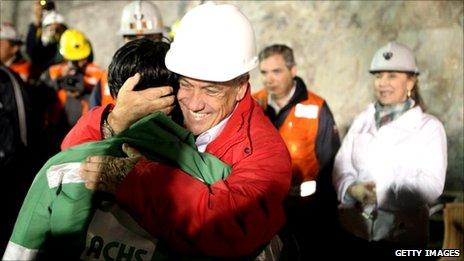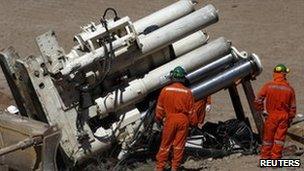The dangers of mining around the world
- Published

The San Jose copper mine in Chile was said to have had a history of accidents
As the last of the 33 Chilean miners emerged from the rescue capsule, there was jubilation around the world.
But the disaster that has gripped audiences globally also serves as a reminder of the dangers of working in a mine.
While industry experts say the number of fatalities has decreased considerably since the early 20th Century, there has been no shortage of tragic mining accidents in recent years.
Although there are no accurate figures, estimates suggest such accidents kill about 12,000 people a year.
Worst offender?
According to the International Labour Organisation (ILO), while mining employs around 1% of the global labour force, it generates 8% of fatal accidents.
Alan Baxter, a Fellow of the Institute of Materials, Minerals and Mining, says standards differ significantly from country to country, but that, overall, the situation appears to be improving.
"Generally there is a downward trend in the severity of the accident, what they call lost-time accidents - where someone has cut themselves and can't work for a few shifts - and in the fatalities," he says.
"Those are dropping worldwide - with perhaps a couple of exceptions, like China and Russia."
China has the world's largest mining industry, producing up to three billion tonnes of coal each year.
But while the country accounts for 40% of global coal output, it is responsible for 80% of mining deaths around the world each year.
In places like China and Russia, says Mr Baxter, the reason for the fatalities is simple: money.
"They are maximising revenue, and the mentality is that life is cheaper than it is here and no-one is going to kick up a fuss if they lose a few lives.
"People are not able to speak freely. If you make a nuisance then you won't have a job," he says.
But conditions do appear to be changing, with China introducing new safety laws and closing some of its worst mines.

President Sebastian Pinera has promised better protection for miners in Chile
For countries like those, he says, "it does get better, but it is the speed at which it is getting better that is the problem".
'Power on paper'
Perhaps unsurprisingly, standards are generally better in developed countries than developing economies, says Joe Drexler, from the international federation of miners' unions (ICEM).
The problems is mainly down to a lack of unions, which he says are a necessary precursor for safety because "it means employees can have power at the workplace rather than just power on paper".
"It is also related to the weakness of the labour laws and enforcement in these countries," he says.
He cites Chile as an example, which he says has more than 900 mines, yet only 18 safety inspectors to regulate conditions.
In this day and age, he says, any fatalities are unacceptable.
"We are in the 21st Century and when we have these mining disasters, whether it is 90 [deaths] in Siberia or 70 in Colombia, these things should not happen at all because the technology is there, the training is there, to ensure that they do not happen," he says.
He says that high price of commodities has not helped the situation, instead adding pressure on mines and workers to increase production.
'Dark industry'
Furthermore, Mr Drexler says, many disasters go unreported.
"It is a very dark industry," he says.
In the US at least, accidents like the one in West Virginia this year, which killed 25 people, focuses the spotlight on enforcement of safety regulations, he says.
Before that disaster, deaths caused by mining in the US had fallen to its lowest ever figure. Fatalities in the coal mining industry in the US had been declining since 2006, dropping steadily from 47 deaths to only 18 in 2009.
In the wake of the Chilean disaster, the largest union in South Africa has reiterated calls for tougher safety standards.

Chile is one of the world's biggest copper producers
South Africa has a chequered record of safety compared with other large industrialised countries, in part because its mines are so deep.
Senzeni Zokwana of The National Union of Miners (NUM) in South Africa told Reuters that the country had the capacity and the means to maintain safety, but said better laws were needed.
"For miners to die in a situation where we think it is preventable is a lack of will on the part of employers," Ms Zokwana said.
In Chile, 34 people have died every year on average in mining accidents since 2000. Smaller mines in the north of the country are widely seen as the most dangerous.
According to Chilean President Sebastian Pinera, the 125-year-old San Jose mine had a "long history" of accidents.
Only a month before the accident, Gino Cortez, 40, lost his left leg in a rockfall. He is taking legal action against the mine, arguing that it failed to put up the necessary metallic screens to protect workers.
President Pinera has already said he will offering new proposals to ensure the safety of Chilean workers.
The group of miners, now known as Los-33, will not be the only ones watching to see if that happens.